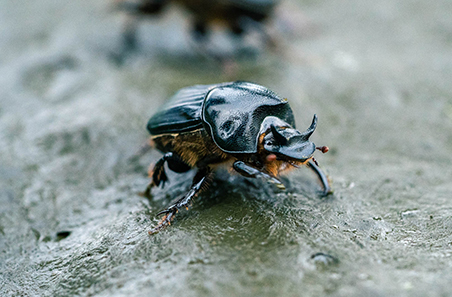
Did you know…?
Australian livestock produce about 80-million tonnes of dung a year, which can take months to break down and results in a large portion of pasture surfaces not being grazed efficiently.
That’s where dung beetles come in.
Stay informed with the latest red meat and livestock industry news, events, research and marketing.
Dung beetles play a critical role in Australia’s grazing ecosystems. By burying dung in the soil, beetles improve the flow of water, nutrients and carbon into the root zones of pastures, which in turn:
For more information on dung beetles, see below or visit dungbeetles.com.au:
Australian livestock produce about 80-million tonnes of dung a year, which can take months to break down and results in a large portion of pasture surfaces not being grazed efficiently.
That’s where dung beetles come in.
Watch this video to find out more about the benefits of dung beetles for livestock producers.
Video courtesy of Dung Beetle Ecosystem Engineers.
What should producers consider before introducing dung beetles on their property?
Firstly, producers should identify which beetle species are currently present on their property – see ‘What species are near me?’ below.
This is important as different beetles are active at different times of the year (see ‘Introduced species in Australia’), and gaps in activity will require different beetles to be introduced for maximum benefit.
Producers should select a supplier who specialises in distributing beetles to their region. Beetle suppliers will be able to assist in the appropriate steps for each producer to take to ensure successful introduction.
|
Species |
Length |
Flight time |
Distribution |
|
Copris elphenor |
20–25mm |
Night |
Queensland (Biloela) |
|
Euoniticellus fulvus |
8–12mm |
Day |
WA, SA, Victoria, NSW, Tasmania |
|
Euoniticellus intermedius |
7–9mm |
Day |
Throughout Australia except very dry and southern-most regions |
|
Euoniticellus pallipes |
9–12mm |
Day |
WA, SA, Victoria, NSW |
|
Euoniticellus africanus |
8–13mm |
Day |
South-east Queensland, eastern NSW |
|
Liatongus militaris |
8–10mm |
Day |
Queensland, NT, north-east NSW |
|
Onitis alexis |
13–20mm |
Dusk and dawn |
Throughout Australia, except Tasmania |
|
Onitis aygulus |
20–25mm |
Dusk and dawn |
WA, SA, Victoria, NSW |
|
Onitis pecuarius |
15–20mm |
Dusk and dawn |
South-east Queensland, eastern NSW |
|
Onitis vanderkelleni |
15–20mm |
Dusk and dawn |
Queensland (Atherton Tablelands and Gold Coast) |
|
Onitis viridulus |
18–23mm |
Dusk and dawn |
Queensland, NT, north-east WA, north-east NSW |
|
Onthophagus binodis |
11–13mm |
Day |
WA, SA, Victoria, NSW, Tasmania, south-east Queensland |
|
Onthophagus gazelle |
10–13mm |
Dusk and dawn |
Northern and eastern Australia |
|
Onthophagus nigriventris |
10–12mm |
Day |
Coastal NSW, south-east and highland tropical Queensland |
|
Onthophagus taurus |
8–10mm |
Day |
WA, SA, Victoria, Tasmania, NSW |
|
Sisyphus rubrus
|
6–8mm |
Day |
Central NSW, southern and eastern Queensland |
|
Species |
Length |
Flight time |
Distribution |
|
Copris hispanus |
16–26mm |
Night |
WA (near Williams) |
|
Onitis caffer
|
15–20mm |
Dusk and dawn |
WA, NSW, south-east Queensland |
|
Bubas bison
|
13–19mm |
Dusk and dawn |
WA, SA, Victoria, southern NSW
|
|
Species |
Length |
Flight time |
Distribution |
|
Geotrupes spiniger
|
20–25mm |
Dusk and dawn |
Tasmania, Victoria, south-east and north-east NSW |
|
Sisyphus spinipes
|
9–11mm |
Day |
Queensland, north-east NSW |
|
Species |
Length |
Flight time |
Distribution |
|
Onthophagus sagittarius
|
10–13mm |
Dusk and dawn |
Coastal QLD, NT, far north-east NSW |
|
Species |
Length |
Flight time |
Distribution |
|
Onthophagus vacca
|
7–13mm |
Day |
Now being distributed in select locations |
|
Bubas bubalus
|
13–22mm |
Night |
Not yet established |
Use this interactive map to find the dung beetle species known to be present near you.
MyDungBeetle Reporter lets you quickly and easily report your observation.
The Ferguson family has seen the soil health benefits from dung beetle activity at their property for more than four decades.
Interactive map of dung beetle sightings reported during the DBEE project only.
Frequently asked questions about dung beetles.
The Dung Beetle Ecosystem Engineers (DBEE) project is currently rearing beetles for distribution to selected sites. These include new species of beetles that are currently not widely available in Australia.
To register your interest in participating in the project, visit: dungbeetles.com.au/get-involved
In addition, producers can report which beetles are located on-farm to assist with DBEE project monitoring using the DBEE phone app.
Program Manager – Sustainability and CN30
E: dmcnicholl@mla.com.au
Dung Beetle Ecosystem Engineers (DBEE)
E: dungbeetle@csu.edu.au
W: dungbeetles.com.au
F: DBEE Facebook page




